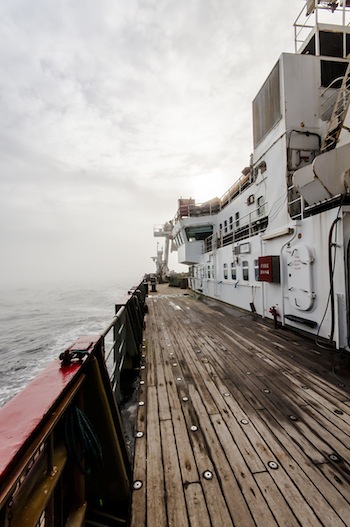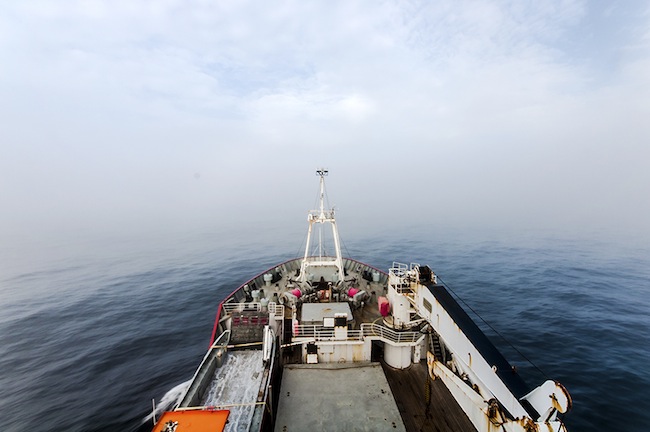Dispatch 2: Imagine
30th July 2012
 Looking Aft |
It’s thick o’ fog this morning. With its perpetually cold water and warmer air, the Arctic is famous for profuse fog. Sheets of it, like soft rain, are wafting across the decks in the light breeze. Peer into the murk for a time and you begin to see things, a whale languidly rolling, that black steel bow on a collision course, the Flying Dutchman. Fog anxiety must have stripped years from the lives of Arctic mariners in the centuries before radar. But in a way the relationship between mariners and fog is quite like that between oceanographers and oceans. Geologists, botanists and biologists, even astronomers can, if with magnification, see their subjects, but not oceanographers. They can see the surface, but that’s as nothing. The average depth of the North Atlantic is 12,000 feet, and there’s a lot going on down there essential to the science. No, oceanography requires imagination to see that which cannot be seen.
To the landsman, the beach-goer, those Melville named “water gazers,” the ocean seems an undifferentiated pool of water sloshing between continents. A tiny portion of the ocean’s motion—waves and tides—is visible from land, but to apprehend ocean motion from the oceanographer’s perspective, we need to cast our imagination out across vast distances in three dimensions. But we need to grasp two principles fundamental to oceanography in order to understand the purpose and trajectory of this or any other oceanographic cruise, indeed to understand the ocean itself.
First, the ocean is alive with motion in the form of ocean currents, a technical as well as a descriptive term. They course through the body of the ocean as if blood vessels in a living organism. Some ocean currents flow on the surface, the Gulf Stream being perhaps the most familiar of these, driven by permanent global wind belts, and others flow through the deep, opaque depths guided by the force of Earth’s rotation. Some ocean currents are warm, others cold. They wobble somewhat in direction and vary in velocity, but they remain permanent features of the ocean’s motion, and so they take proper-noun names: North Equatorial Current, North Atlantic Current, Canaries Current, and of course the Gulf Stream, to speak only of those in the North Atlantic Ocean, but similar currents obtain in all the world’s ocean.
"And without their gift of moderation, vast swaths of Earth’s surface would be rendered uninhabitable, either sweltering hot or frozen solid."
A professional scientist might devote his/her entire career to understanding a single current, and the language of the science can seem pretty esoteric, not to mention the tools required to measure a current running thousands of meters beneath the surface. However, ocean currents matter a great deal to the rest of us, even if we’ve never heard of them, because they transport heat from where there is too much—the tropics—to where there is too little—the high latitudes—and vice versa. By circulating, currents moderate world climate. And without their gift of moderation, vast swaths of Earth’s surface would be rendered uninhabitable, either sweltering hot or frozen solid.
And that brings us to the other fundamental oceanographic principle we need to grasp in order to understand our purpose here in the foggy, cold Denmark Strait: the identity of water masses. As they course through the depths, currents retain a distinguishable fingerprint in the form of temperature and salinity. By measuring both, scientists can follow the water wherever it flows. For example, in 2008 in these same waters aboard a different ship, Bob Pickart, our chief scientist then and now, called me to his computer displaying a cross section of the water he’d been measuring near the mouth of a fjord well above the Arctic Circle on the east Greenland coast. The common program he used showed various water masses in the Greenland Sea in different colors, and he pointed to a mass of “yellow” water.
“Do you know what that is?” he asked. “That’s Gulf Stream water.” The man is a world-class expert on Arctic and subarctic ocean circulation with years of sea time, but you could hear the wonder in his voice, Gulf Stream water in an East Greenland fjord a half a world away from its origin. Imagine.
- Dallas

Looking forward
















